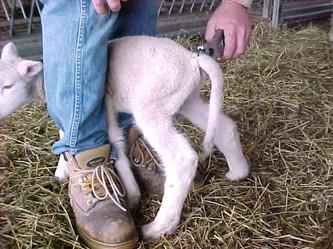Completion requirements
View

The docking of a sheep’s tail is compulsory as filth and dung accumulate under the tail (especially when diarrhoea occurs) thus aggravating the blowfly infestation if present. Tails should be docked at a young age to lessen the shock. Lambing percentages will also increase, as the tails of ewes do not interfere with the mating process. Sheep with docked tails, due to their stocky appearance, are also more acceptable to butchers.
Methods of Docking of Tails
Knifes
- Should be sterilized and dipped into a disinfectant after each lamb was docked.
- Hold the lamb in an upright sitting position, with the front and hind legs together and the back of the lamb against the chest of the person holding it. The tail will hang down.
- Push the skin back towards the body so that the stump of the tail will be covered by skin afterwards.
- Cut off the tail at the desired length and disinfect the wound with a disinfectant.
Pincers
- Similar to emasculator.
- The same as described above but using pincers instead of a knife.
Elastrator
- This method has the advantage that the tail can be amputated very short, but it is more painful.
- The rubber ring is placed around the tail close to the body and left there until the tail falls off or the necrotic end of the tail is cut off two to three days after application. Disinfect the wound to prevent infection.
- Haemorrhage is then eliminated. (The younger the lamb, the better)
Warm Iron
- A sharpened, red-hot iron (e.g. blades of a motorcar) is used for this purpose.
- The lamb is held in a sitting position while the person holding it, holds all four legs together.
- The tail is stretched out along a small plank and the hot iron is then pressed down and through the tail at the desired length.
- There is usually very little bleeding and the heat seals off the wound, thus diminishing the chances of infection.
Complications
- Haemorrhages
- Infection of the spinal cord
- Gangrene
- Oedema
- Tetanus
- Abscess in inguinal glands
- Local abscess or other infection
Click here to view a video that explains lamb tail docking.